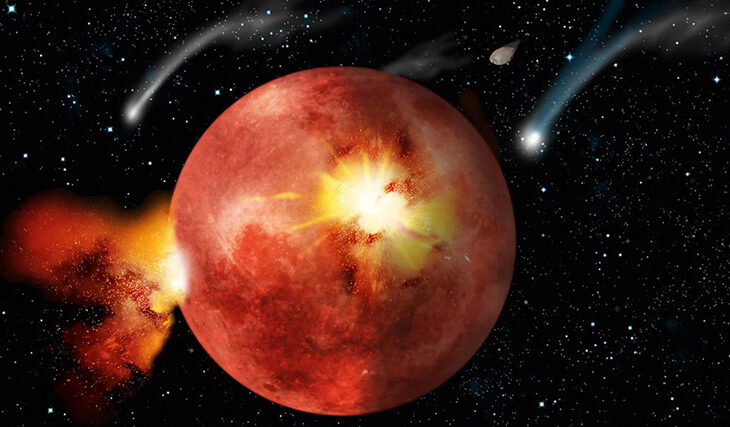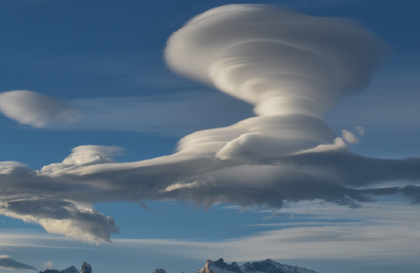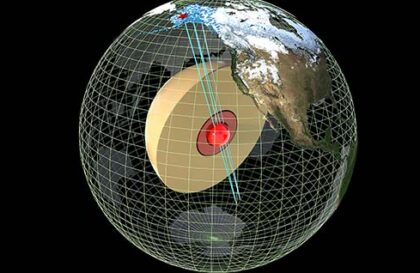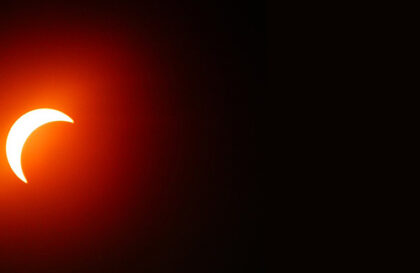Bombardment from space
Most space objects penetrating the Earth’s atmosphere are quite modest in size. According to NASA, they are small, typically around 1 meter in diameter. This is beneficial for the inhabitants of the Earth since space objects with a diameter of less than 25 meters usually do not overcome the atmospheric barrier. The tremendous speeds with which these objects enter the atmosphere cause the gases to heat up, leading to their combustion. Usually, after this explosion, the remains of a space object, even if they reach the surface, pose practically no threat.
An example is a meteorite that was about 17 meters wide and exploded in the atmosphere over Chelyabinsk in 2013, causing a shock wave and damage to windows in houses. But despite this, the meteorite could not create a crater, as it practically did not touch the surface of the Earth. According to Gerhard Drolshagen, a near-Earth object specialist at the University of Oldenburg in Germany, most of the meteorites shattered into pieces and produced only dust and tiny meteorite fragments. At the bottom of a nearby lake, a 5-foot-wide meteorite and a few tiny fragments were found, making up everything left of him.
Impact craters are formed when a meteoroid strikes a planet’s surface, excavating surface material, according to the Moon and Planet Institute. These percussive structures are usually excavated holes of a roughly circular shape.
According to the Center for Planetary and Space Sciences (PASSC) at the University of New Brunswick in Canada, there are 190 confirmed impact structures on Earth. You can explore from the comfort of your own home using Google Earth. Most meteorites landed in North America – 32%. In Europe 22%, in Russia and Asia 16%.
Vredefort Dome
In South Africa, the Vredefort crater, also known as the Vredefort Dome, is the largest known impact crater in the world, according to NASA’s Earth Observatory. Scientists believe the impact created a crater 111 to 186 miles (180 to 300 kilometers) wide, but because the crater has been eroded for over 2 billion years, its exact size is difficult to determine.
Chicxulub
On the Yucatan Peninsula in Mexico lies a crater about 180 km wide, which arose from the impact of a 12 km wide asteroid with the Earth 66 million years ago. At the moment of impact, the crater was underwater, although now it is partially located on land. This collision led to the extinction of 75% of the species of living beings, including dinosaurs.
The collision was accompanied by the ejection of stones and debris into space. Scientists believe that flaming rock fragments may have returned to Earth and started global fires. The impact could also have created a dusty cloud that blocked sunlight and disrupted ecosystems. The surviving dinosaurs may have faced starvation due to lack of food.
Sudbury Basin
It is located in Ontario, Canada, and is the third largest and one of the oldest known impact craters on Earth. A 2014 study found that the basin was formed by a giant comet or a rocky mixture of asteroid fragments and ice. A space object with a diameter of 10 to 12 km collided with the Earth about 1.8 billion years ago.
Now there is flourishing mining of nickel and iron.
Acraman
Acraman Crater, the sixth largest in the world, is hidden in southern Australia. Its formation, which occurred 590 million years ago, extends for 45 kilometers. At that time, the fall zone was a shallow and warm sea inhabited by primitive mollusks and arthropods. A meteorite impact scattered their remains with sedimentary rocks hundreds of kilometers around. The outline of the crater has blurred over time, but it is visible on satellite images.
At present, Arkaman looks less impressive, since a significant part of it is occupied by a seasonal lake that dries up in the heat. However, 590 million years ago, the fall of a meteorite shook the entire planet. The diameter of this space traveler was 4 km, and it consisted of chondrite – a meteorite relative of terrestrial granite. When hitting the ground at a speed of 25 km / s, the Arkaman meteorite exploded with an energy of 5200 gigatons, which is approximately equal to the total power of the entire nuclear arsenal of the world. Thunder with a volume of 110 dB, causing pain and hearing damage was heard even at a distance of 300 kilometers from the place of impact, and a squall of wind with a force of 357 m / s could even demolish skyscrapers.
Popigai crater
The Popigai crater is the largest meteorite impact trace on the territory of modern Russia, located in northern Siberia. Its diameter reaches about 100 kilometers, and even the population lives in it – the village of Popigay, numbering about 340 people, is located only 30 kilometers from the center of the crater. This huge footprint was left by an 8-kilometer chondrite meteorite that fell into the territory of Eurasia 37 million years ago.
The impact of the asteroid gave special significance to this crater – deposits of graphite under the surface turned into impact diamonds within 13.6 kilometers of the impact site. These diamonds are small, have a diameter of up to 1 cm, and therefore are not suitable for jewelry purposes. However, their outstanding hardness is highly valuable in industry and scientific research, as these “meteorite” diamonds are stronger than even the hardest artificially created ones.
Credit рhoto:
https://www.wondriumdaily.com
https://www.newscientist.com
https://www.sudbury.com/local-news
https://www.australiangeographic.com.au






